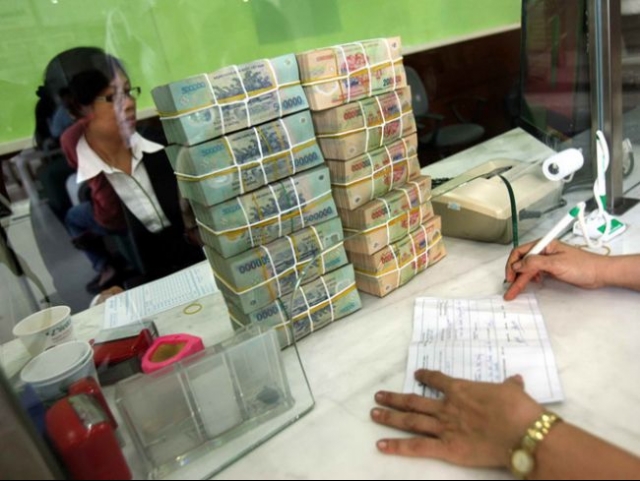|
HSBC: Easily-achievable credit growth may turn risky
A 21 per cent credit growth
target could be easily achieved, given the current pace of credit growth and
the rate cuts in July, but the misallocation of credit towards less
productive industries, such as real estate and State-owned enterprises
(SOEs), at the expense of small and medium-sized enterprises (SMEs), will
eventually affect credit quality, HSBC said in its latest report.

Prime Minister Nguyen Xuan Phuc has
been calling for an increase in the credit growth target from 18 per cent to
21 per cent in the hope of reaching the government’s 6.7 per cent GDP target
for 2017. After the economy grew at just 5.7 per cent in the first half and
in light of already high public debt, Vietnamese officials are signaling that
they aim to achieve higher growth via the credit channel.
In a surprise decision, the State
Bank of Vietnam (SBV) cut its refinancing rate by 25 basis points to 6.25 per
cent, alongside simultaneous cuts to other rates. Government expenditure has
been on watch due to rising public debt, which is nearing the government’s
self-mandated limit of 65 per cent of GDP. An SBV survey right before the
rate cut revealed that credit growth for 2017 was expected to reach just 16.3
per cent, which is lower than the central bank’s original 18 per cent target.
This is not to say that credit
growth has been slow. The pace of Vietnam’s credit growth has continually
increased over recent years, with first half growth at its fastest for six
years. Assuming growth over the remaining months remains exactly in line with
last year’s result, HSBC believes credit growth should reach 19.3 per cent by
year-end, while the SBV’s rate cuts in July should also push up the pace of
credit growth toward the new target of 21 per cent.

Risky business
It’s worth noting, however, that
rapid credit growth may create new risks for the banking sector, especially
if it is placed in less productive industries.
For instance, real estate-related
sectors still appear to be contributing the most to total credit growth,
despite their declining contribution in recent months.
The country’s real estate sector,
which sank after a bubble in 2006-2008, was one of the primary reasons for a
rise in non-performing loans (NPLs) and the country’s banking sector crisis
in 2011.
Both the International Monetary Fund
and the World Bank have noted in recent studies that SOEs are absorbing a
disproportionate amount of credit in the Vietnamese economy at the expense of
SMEs.
An empirical study from the IMF also
showed that SOEs borrow at lower interest rates than private firms, enabling
weak SOEs to access bank funding to avoid shrinking their balance sheets.
Meanwhile, a World Bank survey of
Vietnamese enterprises showed that only 29 per cent of small enterprises
(1-20 employees) have an active credit line, with SOEs and large domestic
companies taking the lion’s share of credit in the market.
The data thus suggests that high
credit growth alone is not enough to lift Vietnam’s economic growth.

The misallocation of credit and the
crowding out of private investments may weigh on GDP growth and increase the
risk of future NPLs if left unchecked.
In addition, the decline of the
NPL-to-total-loan ratio in recent years somewhat belies the true level of
problematic loans in the economy.
“Part of the reduction in NPLs is
due to transfers to the Vietnam Asset Management Company (VAMC), where the
underlying credit risks of such loans have not been fully eliminated,” HSBC
economist Mr. Noelan Arbis noted.
Positive signs

At the very least, the government
seems to be aware of the importance of containing credit growth in less
productive industries.
Since the end of August, it has
asked banks to restrict lending to the real estate sector, among others, to
stem low-productivity lending.
Official data also suggests that the
trade, transportation, and telecommunications sectors have been larger
contributors to credit growth since the beginning of the year, which is a positive
development and may help improve the domestic industry’s export
competitiveness.
Moreover, the government has
recently enacted new measures that make it easier for banks and the VAMC to
repossess collateral in the event of borrowers’ default, increasing their
power to recover assets from NPLs.
Ongoing SOE equitization and reforms
also remain crucial to levelling the playing field for credit access, as it
could help divert credit away from supporting weak SOEs and to helping boost
private sector investments.
“As we have previously noted, this
is an area where there has been growing momentum as non-State investments
have recently caught up to State investments in percentage of total
investments in the economy,” Mr. Arbis said.
Overall, supporting economic growth
through the credit channel is a reasonable strategy given the rising role of
private consumption and non-State investments. Moreover, rising public debt
may be an impediment to increased government spending in the future.
However, the quality and allocation
of credit, in addition to resolving existing NPL issues, are crucial to
ensuring that increased credit growth translates to higher and more
sustainable growth in the future.
VN
Economic Times
|
Thứ Ba, 12 tháng 9, 2017
Đăng ký:
Đăng Nhận xét (Atom)
Không có nhận xét nào:
Đăng nhận xét